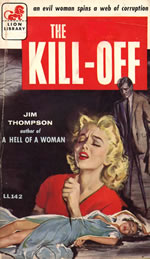The Kill-Off
 Cover Artist: William Rose
Cover Artist: William RoseBy: Thompson, Jim
Publisher: Lion Books, Inc. (LL 142)
Place of Publication:New York, NY
Catalog #: Kelley Box 381: PS3539 .H6733 K54 1957
Contributor: J. Lukin
General
Era: 1950sAuthor as on Cover: Jim Thompson
Publication:1957
Original Date: 1957
Setting: small town; homes and workplaces of this depressed former resort town -- professional classes, entertainers, and poorer people
Plot Summary
In the small East Coast town of Manduwoc, everyone knows everyone else's business. Privacy has ceased to exist, largely thanks to the efforts of the town gossip, Luane Devore, who lies in bed all day telling colorful stories over the phone about her neighbors. When the subjects of her gossip have no dark secrets, she magnanimously makes some up for them. But she may have gone too far: her victims have begun retaliating with gossip of their own, and some aren't going to be satisfied with verbal revenge. Each of the novel's twelve chapters is told from the point of view of a different character, and each introduces more townspeople with a motive for murdering the old yenta. There's the brilliant young man whose psyche and reputation have been ruined by the revelation of his biracial ancestry. There's the politician whose career will be hurt by a rumor of incest. There's the Jewish attorney who may be fed up with talk of his alleged dishonesty. There's Luane's young husband, who is having his first love affair and wants a little freedom. There are many more, each of whom has friends who might just do the job out of loyalty to them. Will we ever see clearly through the seething miasma of shame, rage, and desire that Luane has unleashed and find out who does her in?Major Characters
Isidore Kossmeyer adult male, Jewish, middle-aged, five feet tall, attorneyHenry Clay Williams adult male, middle-aged, underachiever, county attorney
Luane Devore adult female, 62 years old, chunky, invalid
Hattie adult female, African-American, 40s, beautiful, frightened, housekeeper
Ralph Devore adult male, 40, handsome, odd-job man
Bobbie Ashton adolescent male, biracial, 19 years old, brilliant but embittered, delinquent
Pete Pavlov adult male, about 50 years old, "round-faced, square-built," commercial landlord
Rags McGuire adult male, middle-aged, has-been bandleader who's no longer in touch